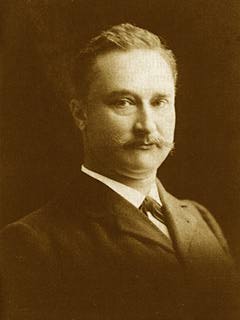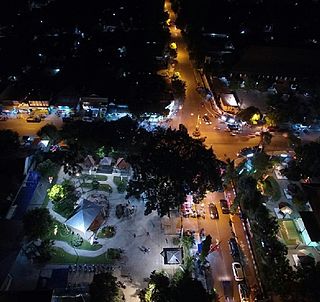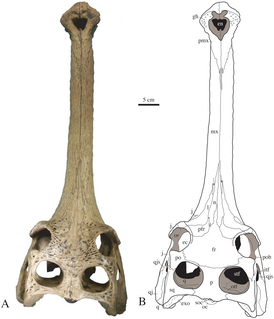
Marie Eugène François Thomas Dubois was a Dutch paleoanthropologist and geologist. He earned worldwide fame for his discovery of Pithecanthropus erectus, or "Java Man". Although hominid fossils had been found and studied before, Dubois was the first anthropologist to embark upon a purposeful search for them.
Meganthropus is a name commonly given to several large jaw and skull fragments found at the Sangiran site near Surakarta in Central Java, Indonesia. The original scientific name was Meganthropus palaeojavanicus, and while it is commonly considered invalid today, the genus name has survived as something of an informal nickname for the fossils.

Solo Man is a subspecies of Homo erectus., identified based on fossil evidence discovered between 1931 and 1933 by Gustav Heinrich Ralph von Koenigswald, from sites along the Solo River, on the Indonesian island of Java, dated to between 550,000 and 143,000 years old. The remains are also commonly referred to as Ngandong, after the village near where they were first recovered.

Java Man is an early human fossil discovered on the island of Java (Indonesia) in 1891 and 1892. Led by Eugène Dubois, the excavation team uncovered a tooth, a skullcap, and a thighbone at Trinil on the banks of the Solo River in East Java. Arguing that the fossils represented the "missing link" between apes and humans, Dubois gave the species the scientific name Anthropopithecus erectus, then later renamed it Pithecanthropus erectus.

Sangiran is an archaeological excavation site in Java in Indonesia. According to a UNESCO report (1995) "Sangiran is recognized by scientists to be one of the most important sites in the world for studying fossil man, ranking alongside Zhoukoudian (China), Willandra Lakes (Australia), Olduvai Gorge (Tanzania), and Sterkfontein, and more fruitful in finds than any of these."

Gustav Heinrich Ralphvon Koenigswald was a German-Dutch paleontologist and geologist who conducted research on hominins, including Homo erectus. His discoveries and studies of hominid fossils in Java and his studies of other important fossils of south-eastern Asia firmly established his reputation as one of the leading figures of 20th Century paleo-anthropology.

Trinil is a palaeoanthropological site on the banks of the Bengawan Solo River in Ngawi Regency, East Java Province, Indonesia. It was at this site in 1891 that the Dutch anatomist Eugène Dubois discovered the first early hominin remains to be found outside of Europe: the famous "Java Man" specimen.

Panthera tigris trinilensis, known as the "Trinil tiger", is an extinct tiger subspecies dating from about 1.2 million years ago that was found at the locality of Trinil, Java, Indonesia. The fossil remains are now stored in the Dubois Collection of the National Museum of Natural History in Leiden, the Netherlands. Although these fossils have been found on Java, the Trinil tiger is probably not a direct ancestor of the Javan tiger. The Trinil tiger probably became extinct 50,000 years ago. The Bali tiger was also not closely related to the Trinil because of their time differences.

Ngawi Regency is a regency (kabupaten) of East Java, Indonesia. Ngawi is well known around the world for its Pithecantropus erectus that was found by Eugene Dubois, a Dutchman. Ngawi is located at the central of East Java province and Central Java province. Ngawi is also the main gate to enter East Java province since there are intersections that connect Surabaya–Madiun–Bojonegoro–Solo–Jogja–Bandung–Jakarta.

Homo erectus is a species of archaic humans that lived throughout most of the Pleistocene geological epoch. Its earliest fossil evidence dates to 1.8 million years ago. However, a 2017 analyses points to these specific fossils being more archaic, being related to H. naledi, which was considered one of the first homo species.
Lenore Margarethe Selenka-Heinemann was a German zoologist, anthropologist, feminist and pacifist. She researched apes and led scientific expeditions to the Dutch East Indies.

Bos palaesondaicus occurred on Pleistocene Java (Indonesia) and belongs to the Bovinae subfamily. It has been described by the Dutch paleoanthropologist Eugène Dubois in 1908. The holotype of Bos palaesondaicus is a skull from Trinil. This species is the likely ancestor to the banteng.

The Mojokerto child, also known as Mojokerto 1 and Perning 1, is the fossilized skullcap of a juvenile early human. It was discovered in February 1936 near Mojokerto by a member of an excavation team led by Ralph von Koenigswald. Von Koenigswald first called the specimen Pithecanthropus modjokertensis but soon renamed it Homo modjokertensis because Eugène Dubois – the discoverer of Java Man, which was then called Pithecanthropus erectus – disagreed that the new fossil was a Pithecanthropus. The skullcap is now identified as belonging to the species Homo erectus.

The terms Anthropopithecus and Pithecanthropus are obsolete taxa describing either chimpanzees or archaic humans. Both are derived from Greek ἄνθρωπος and πίθηκος, translating to "man-ape" and "ape-man", respectively.
The Trinil H. K. Fauna, or Trinil Haupt Knochenschicht Fauna is a biostratigraphic faunal assemblage. It is another interpretation of the collection of fossils gathered by Eugène Dubois at Trinil, where he discovered the early hominid fossils of Java Man. It was proposed in the 1980s a group of Dutch paleontologists to reassess the date of the layer in which Java Man was found.
Hemimachairodus is an extinct genus of saber-tooth cat of the tribe Machairodontini and subfamily Machairodontinae. The type species, Hemimachairodus zwierzyckii was previously assigned to the genus Homotherium.
The region of Southeast Asia is considered a possible place for the evidence of archaic human remains that could be found due to the pathway between Australia and mainland Southeast Asia, where the migration of multiple early humans has occurred out of Africa. One of many evidences is of the early human found in central Java of Indonesia in the late 1800s by Eugene Dubois, and later in 1937 at Sangiran site by G.H.R. van Koenigswald. These skull and fossil materials are Homo erectus or Dubois named Pithecanthropus erectus, and Meganthropus palaeojavanicus by van Koenigswald. They were dated back to c. 1.88 and 1.66 Ma suggested by Swisher et al. from volcanic rocks dating method

Duboisia santeng or Dubois' antelope is an extinct antelope-like bovid that was endemic to Indonesia during the Pleistocene. It went extinct during the Ionian stage of the Pleistocene, about 750.000 years ago. Duboisia santeng was first described by the Dutch paleoanthropologist and geologist Eugène Dubois in 1891.
Mececyon trinilensis, the Trinil dog, is an extinct canid species that lived in Indonesia during the Pleistocene.

Gavialis bengawanicus is an extinct species of crocodilian that is related to the modern Indian gharial. Fossils have been found in Thailand and Indonesia. The type locality is at Trinil.
















